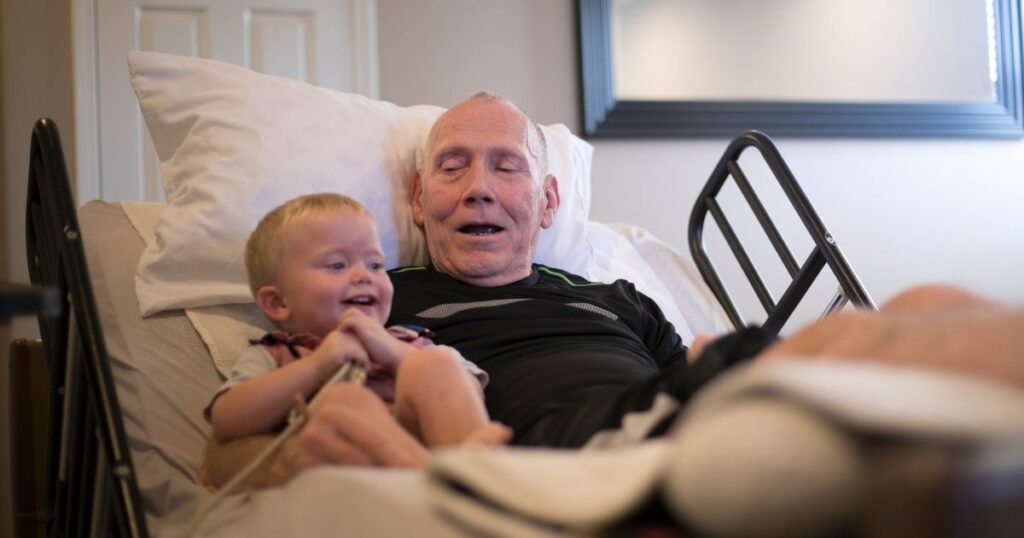Visiting a loved one in hospice care can be a profound and emotional experience. It’s essential to approach these visits with sensitivity, compassion, and preparedness. At Siena Hospice, located at 3305 Spring Mountain Rd, Suite 22, Las Vegas, NV 89102, we understand the importance of making these visits as comforting as possible for both the patient and their visitors. In this blog, we share our top 10 tips for visiting someone in hospice to help you navigate this delicate time with grace and empathy. For more information or support, contact us at info@sienahospice.com or 702-389-2009.

Preparing for the Visit (10 Tips for Visiting Someone in Hospice)
- Check with the Patient’s Family Before the Visit
Before visiting, it’s crucial to communicate with the patient’s family or primary caregiver. This ensures you choose an appropriate time and understand any specific needs or restrictions. Family members can provide valuable insights into the best times to visit and what to expect during your visit. This step helps avoid overwhelming the patient and ensures your visit is welcomed and appreciated.
- Be Prepared for a Range of Emotions
Hospice care involves managing various emotional and physical challenges. As a visitor, be prepared to encounter a range of emotions from the patient, including pain, anxiety, or anger. Understanding these emotions and offering support without judgment is vital. Remember, your presence can provide significant comfort, even if it’s just through listening and being there for them.
- Follow the Patient’s Lead
Let the patient dictate the pace and nature of the visit. Some days they may feel like talking, while other days they may prefer quiet company. Respect their wishes and allow them to steer the conversation and activities. This approach helps the patient feel more in control and comfortable during your visit.
- Respect the Patient’s Privacy
Privacy is crucial in hospice care. Always honor the patient’s wishes regarding information sharing and never divulge details about their condition without permission. Respecting their privacy and confidentiality builds trust and shows your respect for their dignity.
During the Visit
- Offer Reassurance
Providing comfort and reassurance is one of the most important things you can do during a visit. Let them know they are not alone and that you are there for them. Simple words of encouragement and a comforting presence can significantly improve their emotional well-being.
- Bring Appropriate Gifts
Thoughtful gifts can provide comfort and joy to hospice patients. Consider bringing items like audiobooks, favorite music, simple snacks, or family photo albums. These gifts can offer a welcome distraction and bring a sense of normalcy and happiness to their day.
- Be Mindful of the Patient’s Physical Needs
Pay close attention to the patient’s physical comfort. Adjust your visit to accommodate their needs, whether it’s helping them with pillows, offering a favorite snack, or simply ensuring they are comfortable. Asking what would make them more comfortable shows your care and attentiveness.
- Avoid Discussing Plans for the Future
Focusing on the present moment is essential during hospice visits. Avoid discussing future plans or anything that might cause the patient stress or anxiety. Instead, keep conversations positive and comforting, focusing on pleasant memories and enjoyable topics.
Practical and Emotional Support
- Take Care of Yourself
Caring for a loved one in hospice can be emotionally taxing. Ensure you are well-rested and healthy before visiting. Taking care of your own well-being allows you to be more present and supportive during your visits. If you feel overwhelmed, take breaks and give yourself time to process your emotions.
- Offer Practical Assistance
Offering practical help can significantly ease the burden on the patient and their family. Help with daily tasks like grocery shopping, meal preparation, or running errands. This practical support can provide immense relief and allow the family to focus more on spending quality time with their loved one.
Visiting a loved one in hospice care is a powerful way to show support and love. By following these top 10 tips, you can make your visits more meaningful and comforting for both the patient and yourself. At Siena Hospice, we are dedicated to providing compassionate care and support during these challenging times. Remember, your presence and kindness can make a profound difference in the lives of those in hospice care.
FAQs
Q1: How often should I visit someone in hospice care?
A: The frequency of visits depends on the patient’s needs and preferences. It’s essential to communicate with the patient and their family to determine the best visiting schedule.
Q2: What should I avoid bringing to a hospice visit?
A: Avoid bringing items that may cause discomfort or overwhelm the patient, such as strong-scented flowers, large gifts, or foods they cannot eat.
Q3: Can I bring children to visit someone in hospice?
A: Children can visit, but it’s crucial to prepare them for what to expect and ensure they understand the importance of being respectful and gentle.
Q4: What if I don’t know what to say during the visit?
A: It’s okay to simply be present. Sometimes, your presence and a comforting touch are more important than words. Listening and showing empathy can be very powerful.
Q5: How can I support the family of someone in hospice?
A: Offer practical assistance, such as helping with errands or meals, and provide emotional support. Be a good listener and respect their needs and boundaries.
We invite you to share your own tips and experiences in the comments below. For more information and support, contact Siena Hospice at 702-389-2009 or email info@sienahospice.com. Sign up for our newsletter or follow us on social media for updates and more helpful resources.



